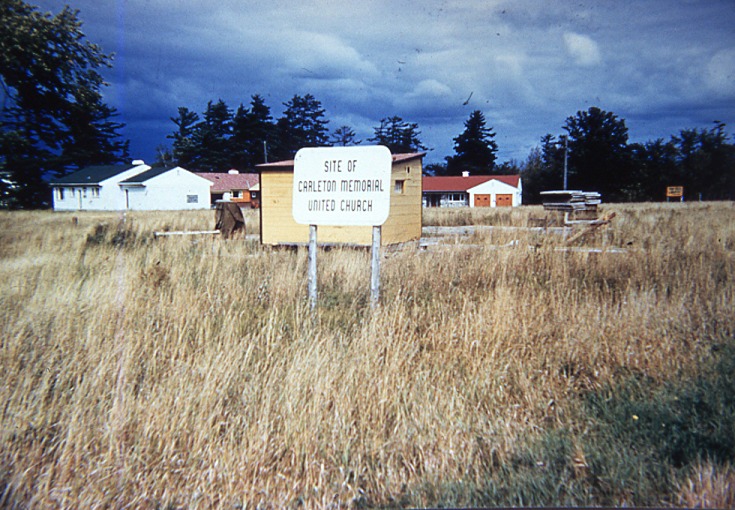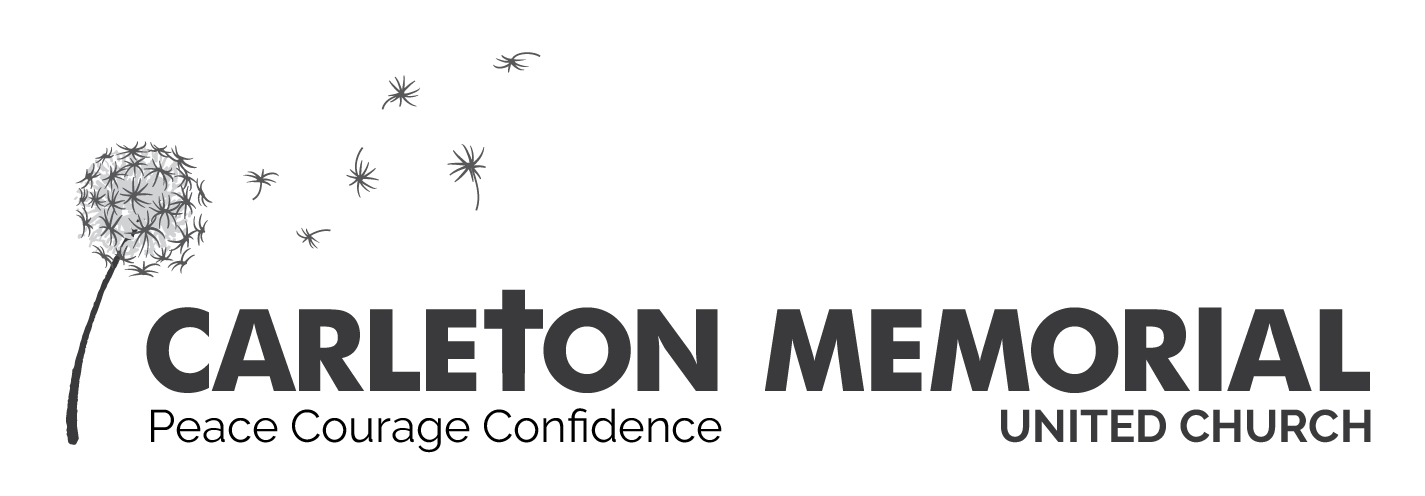
This fall marks the 75th anniversary of the very first service of the Carleton Memorial United Church congregation. In 1949, a small group of neighbours—many of them veterans and young families—came together with a vision of building not just houses, but a community. From those early muddy streets and makeshift Sunday Schools grew the thriving congregation we know today.
To honour this milestone, we’re sharing an excerpt from Make Me an Altar written by Mary Mortimer. a history of our church’s beginnings. It tells the story of the years just after the Second World War, when returning families settled in Carleton Heights and gathered to create a place of worship, learning, and belonging. Their perseverance, humour, and sense of purpose continue to inspire us three quarters of a century later.
We are celebrating this milestone Sunday, October 12 at 10:30 am.
______________
Nineteen forty-six and forty-seven were good years for Carleton Heights. The houses were going up on the Veterans’ Small Holdings. Plans for a few chickens, a couple of geese or rabbits, or a big garden on our half acres were in our minds as we waded through the muddy streets to catch the Colonial Coach that serviced the area. Rubber boots were left at bus stops while people went into the city to work or shop. Not many trees were here then—just a few that had spotted the former hay fields, and the ones along the river, of course. The area between Courtland Park and Carleton Heights was a big field with a pond full of pollywogs and frogs. The roads were dusty in summer, snowy in winter, and slippery with clay in between. Did you ever wonder how Claymor got its name?
An early resident tells the story:
“…this street was the only one at that time that did not have any association with the War. It was originally named for Des Bernieres, a gallant French Canadian officer. However, nobody on the street could pronounce the name, let alone spell it. It did have more clay than any other, so by mutual consent it became Claymor.”
Everyone has a favorite story of children, pets, and even Harold Moffat’s horse stuck in the muddy ground. Many a child-size rubber boot will be exhumed in future archaeological digs.
There was a little store—Lippet’s—on the corner of Hog’s Back and Highway 16 where we picked up our mail. Hog’s Back was a cottaging area for city folks, and we were in the country—at that time, Nepean Township.
But hopes were high. The war was over; families were back together again.Time to move out of the one-bedroom apartments, the upstairs rooms in our parents’ houses. A time to build—a community—a school—a church.
It was too soon to think seriously about a church. Most people were still attending their former city churches, but a group felt it was essential to have a Sunday School of some sort nearby. In late August of 1947, a delegation approached Maurice Morgan to begin an Interdenominational Sunday School. Permission was obtained from the Nepean School Board, Section #14, to use the Harboard School, a small red building (now a private home) on the corner of Dynes Road and Prince of Wales (then the Prescott Highway).
Maurice Morgan recalls it this way:
“The Nepean School Board had given us permission to use the old school. On the surface this appeared a satisfactory arrangement, except that no caretaker was provided; he was available only on regular school days. In order to provide heat for the Sunday School during the winter months of 1947–48, Art Fillman and I went down to the schoolhouse before breakfast each Sunday to light the furnace in preparation for the morning session. Then back home for a bite to eat, and then back again to the school. And so was born the humble Sunday School of twenty-five children and six teachers.
“As we made our weekly pilgrimage, we would talk of the need for a church as well as a Sunday School. We agreed that the need should be talked up among our neighbours, but because few families were living in the area at the time, a year rolled around before sufficient support for a church was forthcoming.”
By 1948, the Carleton Heights School had been built and was rapidly becoming the centre of community activities. It was the natural location for our first church, and on January 31, 1949, some fifty people gathered to form an Interdenominational Congregation.
Under the direction of the Rev. A.E. Martineau of City View, a group consisting of persons from a variety of denominations began to make plans for weekly services in the school. In order to have continuing pastoral oversight, the Board moved that we be associated with the City View–Merivale charge. A Board of Stewards consisting of five members was elected, plus a pulpit supply of three.
Ministers from the Anglican, Baptist, Presbyterian, Salvation Army, and United Churches took turns officiating at the services. Although the lay people got along very well (after all, they had been building houses and wading through the mud together for some months), there were some tense moments when the clergy and pulpit supply tried to determine what indeed was an Interdenominational Service. Anything not structured tended to be regarded as “United.” It did work out eventually, usually on the model of the armed forces services.
The Interdenominational Church operated with morning Sunday School and afternoon services for months. Early in 1950, the Bishop of Ottawa set up an Anglican parish, St. Mark the Evangelist, cutting our ranks approximately in half. It was time to begin our own denomination.
A flyer was distributed throughout the community announcing a meeting inviting persons to “participate in a meeting on Wednesday, September 6, 1950, to discuss the formation of a United Church congregation, the possibility of financing and erecting a church building, and ministerial supply.”
In a new community, advertising is a somewhat delicate problem, especially at that time when most persons had strong church affiliations. The committee put it this way:
“As it is not known with assurance who of us here belong to any particular church family, this invitation is going to all homes. Should you already have a church home, please disregard this notice, as the intention is to seek out those who may be interested, not to encroach upon the domain of other churches.”
At this meeting, Dr. Mackay, Superintendent of Home Missions, explained the policy of the Church “to follow and serve the people as they move into new areas,” because people tend to lose their connection with church life when the community is without a church.
He indicated that land had already been purchased by the Church Extension Committee—the land where our church now stands. He urged the new congregation to continue cooperation with the Anglican Church—advice which has been well taken.
The Rev. E.M. Cadigan, Chairman of the Home Missions Committee of the Ottawa Presbytery, gave some practical hints for the task ahead but noted that it would be accomplished “by the enthusiasm of the people. While money is necessary, the people are the prime requisite… little would be accomplished by individual effort.”
He expressed the hope that we would produce the enthusiasm to go on to the erection of our own church building “where our children would be christened, go to Sunday School, grow up and be married, and where we would all find solace in the time of sorrow. All this would unite the community as nothing else would.”
(Minutes, September 6, 1950.)
Things were in motion. The members formerly on the Interdenominational Committee became a temporary Session. A meeting within a week set up a canvass arrangement for the area. On Sunday, October 1, 1950, the Rev. A.E. Martineau read the words of the Constitution that formally launched us as a congregation:
“By the authority vested in me by the Ottawa Presbytery of the United Church of Canada, I declare this congregation of Carleton Heights and district duly organized and constituted.”
Because of problems with babysitting, two Sundays were designated as Charter Sundays—October 1 and November 5, 1950—with 85 members being on the roll.
The first congregational meeting was held on October 10 at Carleton Heights Public School. Since certain areas were not yet represented, it was decided that only a nucleus of the Session, Board of Stewards, and Trustees would be elected. The first Elders were Don Munro, Maurice Morgan, and Howard Matheson. The first Stewards were Jack Lippet, Alf DeLong, and Alex Michie. The Trustee was Reg Elworthy, while Jack Hempstock continued as Secretary. Within a few weeks, additions were made to the Session: Walter Hamilton, Gar Boland, L. Samuel, and R. (Els) Walsh; to the Stewards: Kay Hempstock, May Clavering, Audrey Morgan, Byng McHab, and Donald Wooff; and to the Trustees: Horace Borthwick and George Michie.
The first act of the Stewards was to order 1951 envelopes!
Several names were suggested for the new congregation: Carleton, Rideau View, St. Andrew’s, and Memorial. None seemed just right, so the decision was deferred. Then Alex Michie suggested Carleton Memorial. As Maurice Morgan said:
“It seemed to be just what we were searching for. Here we were in a veterans’ subdivision, many of us safely returned from the war; what better opportunity to honour those who did not return than to designate our church a memorial to them.”
-Excerpted from Make Me an Altar by Mary Mortimer.

1953

2025










Connect with Carleton Memorial